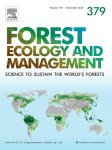Ver ítem
- xmlui.general.dspace_homeCentros Regionales y EEAsCentro Regional Buenos Aires SurEEA BalcarceArtículos científicosxmlui.ArtifactBrowser.ItemViewer.trail
- Inicio
- Centros Regionales y EEAs
- Centro Regional Buenos Aires Sur
- EEA Balcarce
- Artículos científicos
- Ver ítem
Does forest management affect the magnitude and direction of the afforestation effect on soil methane fluxes? A meta-analysis
Resumen
Evidence suggests that tree plantations change soil methane (CH4) fluxes (magnitude and/or direction of the fluxes) compared to herbaceous land (i.e. afforestation effect) due to the effect of trees increasing methanotroph bacteria abundance and enhancing soil gas diffusivity. However, the magnitude of this afforestation effect is highly variable across studies. Here, we evaluated whether the variation in the afforestation effect depends on forestry
[ver mas...]
Evidence suggests that tree plantations change soil methane (CH4) fluxes (magnitude and/or direction of the fluxes) compared to herbaceous land (i.e. afforestation effect) due to the effect of trees increasing methanotroph bacteria abundance and enhancing soil gas diffusivity. However, the magnitude of this afforestation effect is highly variable across studies. Here, we evaluated whether the variation in the afforestation effect depends on forestry management strategies, described by stand age and density, as well as taxonomic identity of the tree species, and the interaction with climatic conditions. To this end, we conducted a meta-analysis using 47 paired samples of afforested and contiguous herbaceous land from 14 studies located in different biomes worldwide. We found that afforestation predominantly increases the capacity of soil net CH4 uptake (i.e. more negative fluxes) compared to herbaceous land, but the magnitude of this effect was highly heterogeneous across paired samples. This heterogeneity was explained by environmental conditions, but significant effects of forest stand age and density were also found proving the importance of forest management on this ecological service. Soil net CH4 uptake following afforestation increases with increasing stand age. Although the stand stocking effect could be tested with a limited number of studies (24 out of the 47 paired samples), the results suggest that net CH4 uptake decreases with tree stocking (stand density) in the range of values up to 1500 individuals per ha. No change in CH4 fluxes was observed above this high stand density. Contrary to our expectations, no effect of taxonomic identity of the trees considering the most planted genera (Pinus and Eucalyptus) was observed in the average soil CH4 fluxes. Furthermore, a significant correlation between the afforestation effect on soil water content and CH4 flux suggests that the most plausible cause of the increased soil net CH4 uptake is driven by the forest impact on soil desiccation, which in turn increases in sites with higher water limitation (i.e. higher potential evapotranspiration and high temporal rainfalls variations within the ranges of the available studies). Finally, our study provides evidence that by modifying rotation time and stand stocking, afforested land may increase its environmental service as a sink of atmospheric CH4.
[Cerrar]

Autor
Fuente
Forest Ecology and Management 507: 120009 (March 2022)
Fecha
2022-03
Editorial
Elsevier
ISSN
0378-1127 (print)
1872-7042 (online)
1872-7042 (online)
Formato
pdf
Tipo de documento
artículo
Palabras Claves
Derechos de acceso
Restringido
 Excepto donde se diga explicitamente, este item se publica bajo la siguiente descripción: Creative Commons Attribution-NonCommercial-ShareAlike 2.5 Unported (CC BY-NC-SA 2.5)
Excepto donde se diga explicitamente, este item se publica bajo la siguiente descripción: Creative Commons Attribution-NonCommercial-ShareAlike 2.5 Unported (CC BY-NC-SA 2.5)


